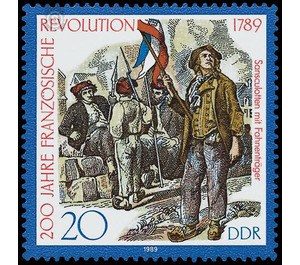200th anniversary of the French Revolution - Germany / German Democratic Republic 1989 - 20 Pfennig
Theme: Art & Culture
| Country | Germany / German Democratic Republic |
| Issue Date | 1989 |
| Face Value | 20.00 |
| Color | multi-colored |
| Perforation | K 13 |
| Printing Type | Rotogravure 2 |
| Stamp Type | Postage stamp |
| Item Type | Stamp |
| Chronological Issue Number | 3001 |
| Chronological Chapter | GER-DDR |
| SID | 64225 |
| In 16 Wishlists | |
200 years of French Revolution On the occasion of the 200th anniversary of the French Revolution, the Ministry of Posts and Telecommunications of the German Democratic Republic issues three multicolored postage stamps. Special cancellation of 4 July is 3 September 1989 200 years French Revolution On 14 July 1989 marks the 200th anniversary of the day when the masses of Paris stormed the Bastille. This started the Great French Revolution. The anniversary is thought of worldwide. This date also stands in the tradition calendar of the German Democratic Republic for the appreciation of important historical events. The special postage stamp of 20 pfennig with the flag bearer of the sans-culottes in front of the group of armed citizens in the background honors the forces of France, to which it was due that this decisive battle of the bourgeoisie with the feudal class "was really fought to the annihilation of the one Kornbattanten, the aristocracy, and to the complete victory of the other, the bourgeoisie "(Engels). During the rule of the Jacobins, the feudal landlordism was destroyed, democratic rights guaranteed to all citizens, and the outer enemy defeated. If the overthrow of the Jacobins in July 1794 was followed by the withdrawal of the democratic achievements by the French big bourgeoisie, then this victorious bourgeois revolution was a landmark of the social progress of that time. "For her class ... for the bourgeoisie, she has done so much that the whole of the nineteenth century ... was under the banner of the French Revolution" (Lenin). The design of the special postage stamps by the graphic designer Joachim Rieß is based on engravings from the revolutionary period.


